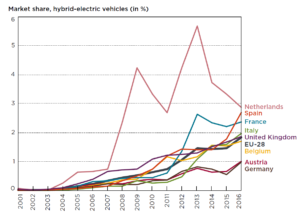 |
|

Fine particles in the exhaust

Of course, diesel vehicles are historically not white as snow. Combustion in diesel engines naturally produces more particles than in their petrol equivalents. Old-generation diesel vehicles emitted large quantities of exhaust particles. But the introduction of particle filter technology from the 2000s and its widespread use in 2009 has drastically reduced particle emissions from these same diesel vehicles.
On the other hand, while gasoline vehicles have traditionally been very low particle emitters, the introduction of direct fuel injection (GDI) technologies to reduce fuel consumption has changed the game. These vehicles emit large amounts of fine particles, especially in cold weather and during strong acceleration. Like diesel, technologies exist to reduce these levels of emissions, starting with the particulate filter (GPF). But the late introduction of standards on particle species has not forced its generalization on the first generations of engine GDI.
Which vehicles are concerned?

In 2016, gasoline direct injection vehicles accounted for 43% of gasoline vehicle sales in Europe and are growing significantly. They are almost universal on the gasoline ranges of premium manufacturers. The general public will distinguish them by various names for each manufacturer: FSI, TFSI, TSI, IDE, THP, PureTech, GCI, GDI, GTE, Ecoboost, SCTi, Skyactiv-G, TCe, Drive-E, GTDi, TBi, Turbojet etc.
What does the standard say?
Up to Euro 4, the European standard only specified a limitation of the particle mass, and therefore did not prioritize the elimination of fine or very fine particles. This is why the Euro 5 standard has introduced a limitation of the number of particles emitted for diesel vehicles, in addition to the mass limit. The Euro 6b standard has extended this limitation to petrol engines, which will mainly affect two-stroke small-displacement engines and direct injection petrol engines, however allowing direct injection petrol cars to emit 6 ×1012 fine particles 2017 while Euro 5 diesel cars are limited to 6×1011 since 2011.
What are the orders of magnitude?

Since the first generations of GDI engines are not constrained by the standard, the technologies required to limit particles have not generally been integrated by the manufacturers. Emissions levels, depending on driving conditions and driving style, can reach up to 1013 particles / km, more than 10 times the recent diesel engines.
Technologies to reduce these emissions include the particulate filter for gasoline engine (GPF), as well as the optimization of injection systems and the shape of combustion chambers. These solutions exist today and are deployed more and more widely on the latest generation GDI engines to pass the standards. Particulate emissions are then much better contained, well below 6×1011regulations.
What does Geco air do?
Geco air now incorporates a particle emission model for GDI gasoline vehicles. These emissions are taken into account when calculating POPs for each of your trips. For example, on an urban commute with a driving style corresponding to the average user of Geco air, taking into account petrol particles will increase your balance sheet by around 10 POPs. This value will double easily if you adopt a more nervous driving.
Emissions out of exhaust: same (bad) report for all vehicles
 |
 |
The abrasion of tires, brakes and the road generates emissions of fine particles.
Which vehicles are concerned?
All vehicles are concerned. And yes, even an electric vehicle emits fine particles, even if the brakes, less stressed thanks to energy recovery when braking, emit less particles compared to a conventional vehicle.
What are the orders of magnitude?
Particulate matter (PM10) emissions from a particular vehicle related to tire, brake and road abrasions are in the range of 10 to 40 mg per kilometer traveled. These levels are far from negligible, beyond the exhaust emission levels of recent gasoline vehicles like Diesel. In 2015, the Air Quality Observatory in Paris area estimated that 41% of suspended fine particles emitted by Parisian road traffic originated from this polluting source.
Of course, these levels depend on many factors: vehicle characteristics (mass, tire pressures, etc.), road profile (sinuosity, slope, slope), driving style (braking intensity and acceleration, cornering speed) , ambient conditions (temperature, rain, snow, etc.) or the type of road surface. The experienced driver can easily hear that the service life of his tires and brake pads depends strongly on his driving style: the same is true for the fine particles caused by this wear!
What does Geco air do?
Geco air now includes fine particle emissions related to abrasion of tires and platelets in the calculation of the environmental footprint of each trip. In order to fully take into account the sensitivity of these emissions to driving conditions, a dynamic model of the vehicle has been developed, taking into account the specificities of each vehicle (mass, center of gravity, tire size, etc.). Based on the speed, slope and heading information provided by GPS each second, this model estimates the forces applied to each wheel of the vehicle, in order to determine, second after second, component wear and emissions. fine particles that result.
These particle emissions are then taken into account in calculating POPs for each of your trips. An average exhaust emission level of 30 mg / km will correspond to a contribution of 15 POPs on the environmental balance of your trip. Depending on the driving style (braking and sudden acceleration, level of anticipation …), these levels will vary from single to double!
Another phenomenon responsible for pollution peaks: the re-suspension

This problem is particularly present in the Nordic countries. Quantities of particles due to abrasion of brakes, tires, and the road, but also to engine emissions and still to winter salting are stored in layers of ice or wet pavement. In spring, the roads dry up and release these accumulated particles throughout the winter. They are then re-suspended by the passage of vehicles, generating episodes of pollution peaks to large fine particles. This phenomenon, which is global at the city level, is very much linked to weather conditions and little to driver behavior, is not taken into account in Geco air.
| To have these new developments and improve the estimate of your environmental footprint, go to the stores to discover the latest version of Geco air, available since April 19, 2018. If you already use Geco air, it will be necessary after this update to delete and then recreate your vehicle, so that the necessary new parameters are determined. |
To go further:







